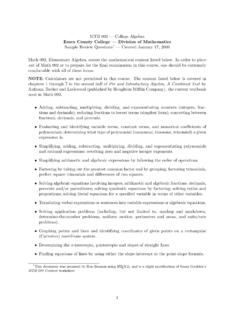Transcription of Orthogonality of Zernike Polynomials - Sigmadyne
1 Orthogonality of Zernike PolynomialsVictor Genberg, Gregory MichelsSigmadyne, Inc. Rochester, NYKeith DoyleOptical Research Associates,Westborough, MA ABSTRACTZ ernike Polynomials are an orthogonal set over a unit circle and are often used to represent surface distortions from FEAanalyses. There are several reasons why these coefficients may lose their Orthogonality in an FEA analysis. The effects,their importance, and techniques for identifying and improving Orthogonality are discussed. Alternative representationsare : Opto-Mechanical Analysis, Zernike Polynomials , CONTINUOUS Orthogonal FunctionsTwo functions F1 and F2 are orthogonal over a unit circle if:0210201= ddFF( )For axisymmetric functions with no variation, the above equation reduces to:022101= dFF( )Consider the axisymmetric functions:21 = 42 = ( )which are the Seidel terms for Power and Primary Spherical.
2 Integrating over the unit circle shows that these are notorthogonal:()()0812221074102 = = dd( )However if the functions are modified as follows,1221 = 166242+ = ( ) Orthogonality is obtained()()()02148618812281812216612210 35724102= + = + =+ dd( )The functions 1 and 2 above are the Zernike Polynomials for Power and Primary Spherical. Note that these functionsare also orthogonal to Bias ( 0=1). For example, the integral of Bias and Power is:()()0214221212210= = d( )Thus Zernike Polynomials were orthogonalized by subtracting appropriate amounts of the lower order terms. The radialvariation of Bias, Power, and Primary Spherical are shown in Figure 1. Standard Zernike Bias, Power, Primary SphericalProducts of sine and cosine functions of different order are also orthogonal over a unit circle:()0)cos(*)cos()sin(*sin2020= = dmkdmk for mk ( )making Zernike trefoil orthogonal to Zernike Zernike polynomialsThe general form of the Zernike series()()()[] + ++= = = =MBMARRAAZNMNMNMMNNNN sincos),(1102000 ( )where()())2(20!
3 2!2!)!(1 SNMNSSMNSMNSMNSSNR = + = ( )and is the dimensionless normalized radius and is the polar angle. Additional restrictions on the series include thatterms only exist when N-M is even and N>M. The Standard Zernike series are given in Born and Wolf1 and includeas many terms as desired. A listing of the Zernike Polynomials is provided in the Standard Zernike Polynomials as defined above have a value of at =1. CodeV uses this normalization. Thesurface RMS of each CodeV unit Zernike polynomial is:Unit axisymmetric polynomial surface RMS = ()[]11 +NUnit non-axisymm polynomial surface RMS = ()[]112 +N Zemax scales the standard Zernikes so that the RMS of each term has a value over the unit circle. The Zemax scalefactors are:Axisymmetric terms = 1+N( )Non-axisymm terms =()12+NThus Zemax Power and Primary Spherical are()123~21 = ()1665~242+ = ( )Thus the same finite element surface displacement is represented by different magnitudes in Zemax and CodeV.
4 Unitvalues of Zemax and CodeV Power and Primary Spherical are shown in Figure 2. 1 Wave of Power and Primary SphericalTo confuse matters more, CodeV and Zemax place the Polynomials in a different order. For instance primary sphericalis term 13 in CodeV and term 11 in Zemax. A comparison list of CodeV and Zemax ordering is given in the alternate set of Zernike terms is called the Fringe Zernike set, which is composed of 37 low order terms, includingthe axisymmetric terms for 10 and 12. The normalization for Fringe Zernikes require that they have a value at =1,like the Standard Zernikes above. For this particular set, both CodeV and Zemax use the same ordering andnormalization. Therefore, Zemax Power for Standard Zernikes is scaled to RMS=1, but Zemax Power for FringeZernikes is Odd geometriesZernike Orthogonality is lost on any surface other than a full unit circle.
5 Consider the primary mirror of a Cassegraintelescope which includes a central hole of = The Orthogonality of Bias and Power (Eqn 7) is now lost:()() = = d( )As one would expect, Orthogonality is also lost on a non-circular geometry, such as a square optic:()()012121111 + + dxdy ( ) DISCRETE Numerical IntegrationFinite element analyses provide surface distortions at discrete locations on an optic. For discrete data evaluated at nodek, equation ( ) becomes:021= kkkkA( )where Ak is the area associated with node k. Using numerical integration on the Bias( 0), Power( 1), and PrimarySpherical( 2) terms, the residual error verses the number of equally spaced radial integration points K over the unitcircle is shown in Table 1. The diagonal terms j j represent the RMS2 and the off-diagonal terms i j represent thecoupling or 1: Numerical integration on a unit circle K 0 0 1 1 2 2 0 1 0 2 1 2 10.
6 34660 .23838 .00500 .01990 .02460 20 .33666 .20990 .00125 .00499 .00623 50 .33387 .20160 .00020 .00080 .00100 100 .33347 .20040 .00005 .00020 .00025 200 .33337 .20010 .00001 .00005 .00006 500 .33334 .20002 .00000 .00001 .00001 1000 .33333 .20000 .00000 .00000 .00000 Note that the coupling terms drop off as prints this Orthogonality check for surface fitting to any finite element mesh pattern. The data in Table 2 is basedon an area weighting calculated internally in SigFit for the finite element areas projected to a flat plane normal to theoptical axis. For the polar meshes shown in Figures 3 (K=10) and Figure 4 (K=20), the Table 2 results correlate closelyto Table 1.
7 In fact, the finite element area calculation provides more accurate answers than the area calculation in theTable 1 integration. Figure 3. Polar mesh with K=10 Figure 4. Polar mesh with K=20 Table 2: SigFit integration on polar meshes with projected areas K 0 0 1 1 2 2 0 1 0 2 1 2 10 .3462 .2370 .0033 .0193 .0220 20 .3366 .2095 .0008 .0049 .0056 Table 3 shows the results for area weighting based on the true curved surface area and Table 4 shows the results for allweighting terms set to 3: SigFit integration on polar meshes with true curved surface areas K 0 0 1 1 2 2 0 1 0 2 1 2 10 .3463 .2374 .0090 .0195 .0246 20 .3366 .2097.
8 0066 .0049 .0079 Table 4: SigFit integration on polar meshes with area weighting set to K 0 0 1 1 2 2 0 1 0 2 1 2 10 .4736 .3346 .2105 20 .4677 .3191 .2105 can be seen from the tables, the projected area provides the best results. Equally weighting nodes (Table 4) whichrepresent different areas provides poor results and should not be Comparison to dynamic modesZernike Polynomials are not the only functions which represent orthogonal functions over a unit circle. The dynamicmode shapes for a uniform thickness circular plate are orthogonal with respect to the mass matrix. For any 2 distinctmodes i and j,0= jTiM( )For discrete data, the above can be written,0= kjkkikM( )For uniform thickness plates, the mass (Mk) at node k is simply the area (Ak) times thickness and mass dynamic mode shapes for circular plates2 have radial coefficients which are Bessel functions rather than simplepolynomials like Zernikes, but the azimuthal terms are identical.
9 The complexity of Bessel functions makes theseshapes less dynamic mode shapes were fit with Zernikes in SigFit as shown in Table 5 for the lowest elastic modes. Mode 1and 2 in Figure 5 are a mode pair which contain only astigmatism terms, of which roughly 95% is primary 3 in Figure 6 contains only axisymmetric terms, of which 90% is power. Other modes contained similar example, Mode pair 4 & 5 contained only trefoil terms, while mode pair 6 & 7 contained only coma terms, and modepair 8 & 9 contained only tetrafoil terms. Essentially, the dynamic modes are very similar to the Zernike polynomialsexcept for slight differences in the radial 5. Zernike fit to dynamic modes ======================================== ====================================== Sigmadyne , Inc. SigFit Version=2002-r1 05-Jun-02 12:33:26 ---------------------------------------- -------------------------------------- CIRCULAR PLATE - 360 DEG - FREE FREE MODES THIN PLATE FIRST ELASTIC MODE SHAPE ---------------------------------------- -------------------------------------- Order Aberration Magnitude Phase Residual Residual N M (Waves) (Deg) RMS P-V Input(wrt zero).
10 4335 2 2 Pri Astigmatism .0200 .1133 4 2 Sec Astigmatism .06225 .0015 .0108 6 2 Ter Astigmatism .00540 .0001 8 2 Qua Astigmatism .00005 .0001 ---------------------------------------- -------------------------------------- THIRD ELASTIC MODE SHAPE ---------------------------------------- -------------------------------------- Order Aberration Magnitude Phase Residual Residual N M (Waves) (Deg) RMS P-V Input(wrt zero) .4978 0 0 Bias .00003 .0 .4978 2 0 Power (Defocus) .0 .0579 .2085 4 0 Pri Spherical .12841.





